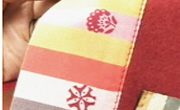This study investigates the current status and dyeing properties of various natural indigo powder dyes in the domestic market. Products from India, China, Europe are sold in the market and only a few manufacturers provide recommendation for the method...
http://chineseinput.net/에서 pinyin(병음)방식으로 중국어를 변환할 수 있습니다.
변환된 중국어를 복사하여 사용하시면 됩니다.
- 中文 을 입력하시려면 zhongwen을 입력하시고 space를누르시면됩니다.
- 北京 을 입력하시려면 beijing을 입력하시고 space를 누르시면 됩니다.


천연 쪽 분말염료의 현황 및 염색특성 연구 = Transactions : A Study on the Current Status and Dyeing Characteristics of Natural Indigo Powder Dye
한글로보기https://www.riss.kr/link?id=A82671159
- 저자
- 발행기관
- 학술지명
- 권호사항
-
발행연도
2011
-
작성언어
-
-
주제어
쪽 ; 분말염료 ; 천연염색 ; 발효쪽 분말 ; 생쪽 분말 ; Indigo ; Powder dye ; Natural dyeing ; Reduced indigo powder ; Dried indigo Leaf powder
-
KDC
500
-
등재정보
KCI등재,SCOPUS
-
자료형태
학술저널
-
수록면
736-747(12쪽)
- DOI식별코드
- 제공처
- 소장기관
-
0
상세조회 -
0
다운로드
부가정보
다국어 초록 (Multilingual Abstract)
This study investigates the current status and dyeing properties of various natural indigo powder dyes in the domestic market. Products from India, China, Europe are sold in the market and only a few manufacturers provide recommendation for the method of dyeing and information on the additives. Through the market research and the preliminary investigation on 21 products, 11 were selected for the dyeing experiment which include 3 Indian, 3 Chinese, 2 German, and 1 Pakistani origin indigo reduced powders, and 2 Indian origin dried indigo leaf powder. The two dyeing methods used were the precipitation method and the fresh juice method, both at 10°C, 25°C, and 60°C. Color difference, K/S value, and colorfastness of dyed cotton fabrics were examined. Indian reduced indigo powder showed the highest K/S value, deep dyeing, and the best color fastness. Chinese reduced indigo powder resulted in a more greenish and bluish color. Powders of dried indigo leaves were easy to use but resulted in a pale color due to low dye uptake.
동일학술지(권/호) 다른 논문
-
추위 훈련이 신체 조성에 미치는 영향 -체중, 체지방량, 골격근량을 중심으로-
- 한국의류학회
- 박주희 ( Joo Hee Park )
- 2011
- KCI등재,SCOPUS
-
지각된 유사성이 패션 브랜드 확장효과에 미치는 영향력에 있어서 소비자-브랜드 관계 질의 조절효과
- 한국의류학회
- 김주현 ( Joo Hyun Kim )
- 2011
- KCI등재,SCOPUS
-
- 한국의류학회
- 이민선 ( Min Sun Lee )
- 2011
- KCI등재,SCOPUS
-
인터넷 쇼핑 시 중요하게 고려하는 의류상품 구매후기 정보에 관한 탐색적 연구
- 한국의류학회
- 홍희숙 ( Hee Sook Hong )
- 2011
- KCI등재,SCOPUS




 ScienceON
ScienceON KISS
KISS





